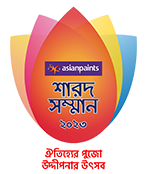Dugga Elo Ghawrey
Trivia
Barowari Puja means a puja arranged and organized entirely by the local community. First organized in Guptipara, a place about 100 kms away from Kolkata, such community pujas spread fast through different parts of West Bengal, particularly Kolkata. The word Baroaari came from Baro (twelve in Bengali) + yaar (friends), ie, in its amalgamated form a puja organized by twelve friends.
Daak-er Saaj is a special kind of gorgeously ornamented outfit of Devi Durga idol, principally made of metallic foils, wires and beads. Initially during the pre-independence period, the foil required to make Daak-er Saaj used to come from Germany by post (Daak in Bengali & Hindi). Hence originated the name Daak-er Saaj.
Ever since Asian Paints Sharad Shamman was introduced cultural ambience within and around the pandal was one major criterion for judgment. By the beginning of 1990s, a considerable number of clubs stressed on improving the overall ambience of there puja. It was during that period the organizers of a puja committee of South Kolkata that won successive Sharad Shamman awards noticed that some of the locals, otherwise absent from puja organizing activities, dressed up very decently in traditional Bengali attire showed themselves up at the pandal throughout the night on which the Asian Paints judges were expected to visit. The organizers, thoroughly amused at this exhibition of artificial cultural exuberance, termed it as APmania, where AP stood for Asian Paints (Sharad Shamman).
The concept of Durga family in West Bengal is something very unique and does not match with the description or explanation of age-old Hindu religious scriptures. Bengal believes that Durga is the mother of Lakshmi, Saraswati, Kartika and Ganesha (Lak-khi, Sharashwati, Kartik and Ganesh as pronounced in Bengali). Shiva (Shibin Bengali) is Durga's husband and father to these four children. Durga's stays in in-law's house in Kailash ( i.e. by definition the abode of Lord Shiva) and every year along with her children she comes to Bengal to visit her mother and other relatives for just five days (Shashthito Dashami). On the contrary, most Puranas and other Hindu scriptures indicated that only Ganesha is the son of Durga. Kartika or Kartikeya is obviously the son of Lord Shiva but his birth was controversial as he was claimed to have born inside the tubular hollow of a water weed. Similarly Lakshmi and Saraswati were described to be the wives of Lord Vishnu but never the daughters of Devi Durga.
In 1997, on the occasion of 12th year celebration of Asian paints Sharad Shamman, general public were invited to predict the Sharad Shamman winners and a few rewards were declared for the participants with closest correct entries. Shrimati Gargi Dutt was the winner of the topmost reward, the much coveted statuette of the Goddess made of gold.
